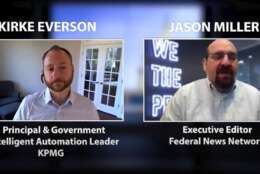Hubbard Radio Washington DC, LLC. All rights reserved. This website is not intended for users located within the European Economic Area.
On Air: Federal News Network
KPMG
-
Although the Federal Sustainability Plan has multiple long-term goals, the White House Council on Environmental Quality is focusing on interim milestones to keep agencies moving forward on an array of green government initiatives.
April 20, 2022 -
While agencies are using more data than ever to drive financial decisions, the government’s CFO organizations must continue to move from being an enabling function to being an empowering one. We share the four factors that make that possible.
April 18, 2022 -
To meet the Biden administration’s net-zero greenhouse gas emission goals, agencies are looking at ways to make their buildings and vehicles more sustainable both through new and existing initiatives. Learn more now.
April 14, 2022 -
As Defense focuses on strategies for meeting the Biden administration energy and sustainability directive, it’s joined with GSA to seek input from industry on ideas across a range of net-zero energy sources. Read more now.
April 11, 2022 -
The contest is open to hardware and software submissions.
April 08, 2022 -
A forthcoming Federal Sustainability Plan will examine disclosures of greenhouse gas emissions from federal suppliers and policies to mitigate climate-related financial risks.
September 10, 2021 -
The demand for a digital-first strategy at federal agencies has only increased since 2020. The pandemic kicked off a massive migration to the cloud; all of the agencies that had not explored it yet, or…
August 17, 2021 -
Experts from the Naval Supply System Command, Marine Force Storage Command, Air Force Sustainment Center and KPMG will explore how the DoD is ensuring a responsive and resilient supply chain.
July 12, 2021 -
Viral Chawda, a principal and head of artificial intelligence, analytics and engineering for the government sector at KPMG, said once agencies truly understand their cyber data, leaders can have insights into things like what applications still don't require multi-factor authentication, what hardware is going out of support, how much of a workload is in the cloud, which devices are using non-compliant software and so much more.
June 04, 2021 -
Adriane Burton, the chief information officer at HRSA, said the grant programs quickly looked to her office for help in getting the money out the door.
April 20, 2021 -
Kirke Everson, a principal and government intelligent automation leader at KPMG, said a lot of agencies are still in the early stages of applying intelligent automation to their business processes.
December 30, 2020 -
Joe Klimavicz, managing director of KPMG and former Justice Department CIO, joins host Aileen Black on this week's Leaders and Legends to talk about leadership and the benefits of being in public service.
December 22, 2020 -
The old adage “trust but verify” is taking on new meaning with the ever-increasing focus on supply chain risk management.
December 14, 2020 -
Joe Klimavicz, the managing director of the federal CIO advisory practice at KPMG and the former Justice Department CIO, said five strategic imperatives emerged for technology leaders over the past few years.
November 13, 2020
















